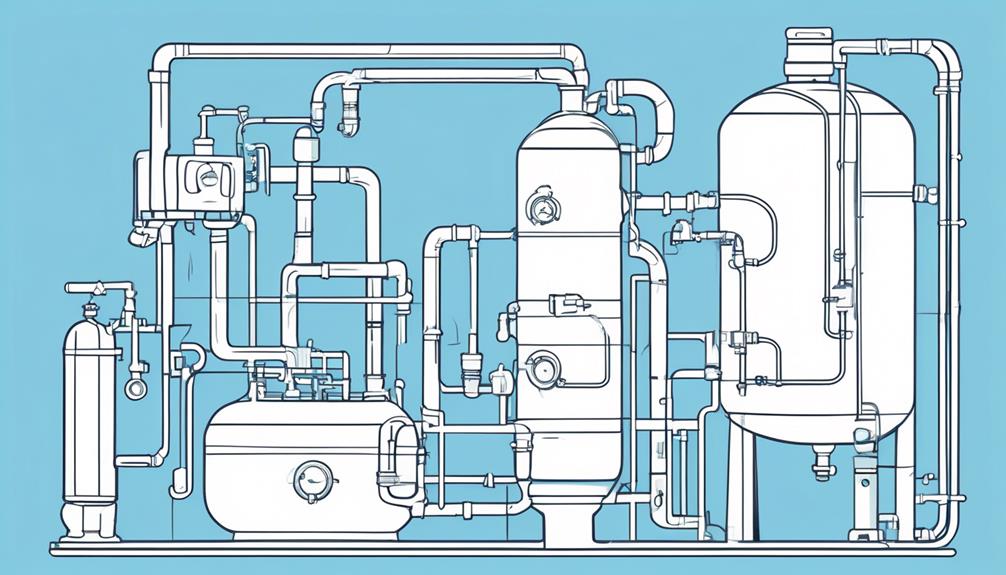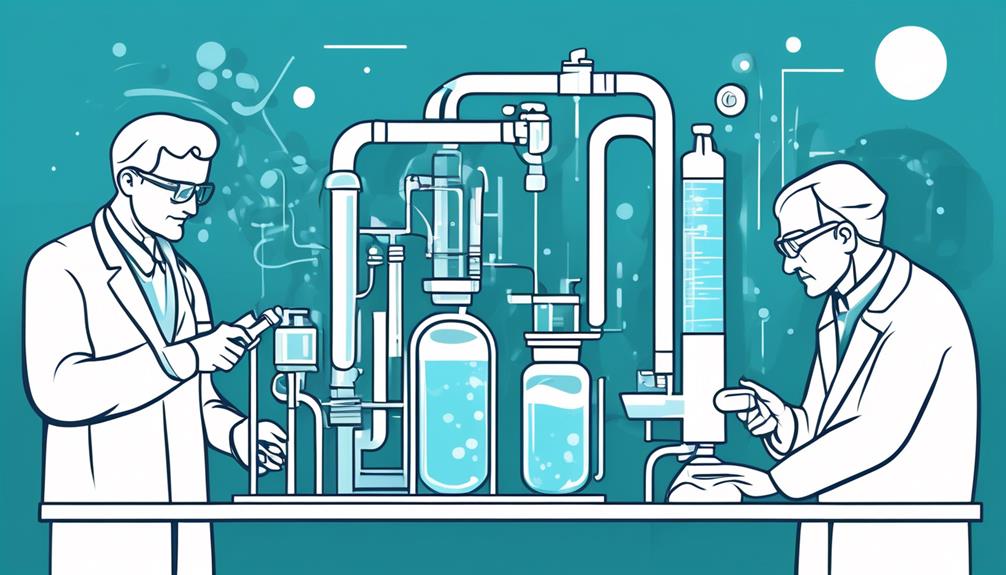Imagine your drinking water as a clear stream, seemingly pure and refreshing. But what if hidden within its depths lurks a silent threat, like a hidden serpent waiting to strike?
As you take that first sip, you may wonder about the unseen dangers that arsenic contamination could pose.
In this guide, we will navigate the intricate waters of arsenic levels in drinking water, shedding light on crucial information that can safeguard your health and well-being.
Key Takeaways
- Arsenic contamination in drinking water poses severe health risks
- Regulatory agencies like EPA and WHO have set limits to control arsenic levels
- Testing methods, including laboratory spectroscopy and field portable kits, are essential for monitoring arsenic levels
- Treatment methods like anionic exchange and reverse osmosis can effectively remove arsenic from drinking water
Understanding Arsenic Contamination
To truly grasp the intricacies of arsenic contamination, understanding the sources and forms of this toxic metalloid is essential. Arsenic can be found naturally in the Earth's crust, and one of the most common ways it contaminates drinking water supplies is through groundwater. Human activities like mining and burning fossil fuels also contribute to arsenic levels in drinking water, compounding the issue. It's crucial to note that arsenic can exist in both organic and inorganic forms, with the inorganic form being particularly harmful to human health. Chronic exposure to arsenic through drinking water can lead to severe health effects, emphasizing the importance of monitoring levels of arsenic in water sources regularly.
Ingesting arsenic-contaminated water can have toxic consequences on health, making it vital to consider effective treatment technologies like reverse osmosis or anion exchange to remove arsenic. By understanding the various sources, forms, and health effects of arsenic contamination in drinking water, you can take steps to safeguard yourself and your community from this hazardous metalloid.
Health Risks of Arsenic Exposure
Understanding the sources and forms of arsenic contamination is crucial because chronic exposure to this toxic metalloid can have severe health risks, impacting various body systems as a known human carcinogen. Arsenic exposure through drinking water can lead to a myriad of health issues. Long-term ingestion of arsenic has been linked to skin lesions, cardiovascular diseases, neurological effects, and an increased risk of various types of cancer, including skin, bladder, and lung cancer. The levels of arsenic in drinking water must be closely monitored to prevent these detrimental health outcomes.
Arsenic, tasteless, odorless, and colorless, poses a significant challenge as it can't be detected without specialized testing. This makes it even more crucial to ensure that drinking water sources are regularly tested for arsenic levels. By being proactive in monitoring and controlling arsenic exposure through drinking water, you can significantly reduce the associated health risks and protect yourself and your loved ones from the harmful effects of this toxic metalloid.
Legal Limits for Arsenic in Water
So, you want to know about the legal limits for arsenic in water.
The EPA and WHO both set it at 10 parts per billion.
It's crucial to understand these limits, the health risks, and how to comply with the standards.
Regulatory Arsenic Levels
Regulatory agencies worldwide have established legal limits for arsenic in drinking water to protect public health. The Environmental Protection Agency (EPA) sets the allowable level for arsenic in drinking water at 10 parts per billion (ppb), in line with the World Health Organization's provisional guideline. The FDA also monitors arsenic levels in animal byproducts used for food, ensuring safety across various sectors. Workplace standards, such as OSHA's permissible exposure limit of 10 micrograms per cubic meter of air, further safeguard individuals from excessive arsenic exposure. Additionally, the EPA enforces specific standards to control arsenic emissions from different sources, illustrating a comprehensive approach to managing arsenic levels in water.
| Regulatory Agency | Arsenic Levels in Drinking Water |
|---|---|
| Environmental Protection Agency | 10 ppb |
| World Health Organization | 10 ppb |
| Food and Drug Administration | Tolerance levels in animal byproducts |
| Occupational Safety and Health Administration | Permissible exposure limit of 10 μg/m³ |
Health Risks Associated
To comprehend the health risks associated with legal limits for arsenic in water, consider the potential impacts on human well-being and safety. When it comes to arsenic levels in drinking water, here are three key points to keep in mind:
- Health Risks: Arsenic exposure can lead to various health issues, including skin damage, circulatory problems, and an increased risk of cancer.
- Water Treatment: Proper water treatment is essential to reduce arsenic levels and ensure safe drinking water for communities.
- Regulatory Standards: Adhering to regulatory standards for arsenic in water is crucial to protect public health and prevent harmful effects of arsenic exposure.
Understanding the health risks associated with arsenic in drinking water highlights the importance of maintaining safe arsenic levels through effective water treatment methods and regulatory compliance.
Compliance With Standards
Ensuring safe drinking water for public health requires compliance with legal limits for arsenic in water. The Maximum Contaminant Level set by the EPA is 10 parts per billion (ppb), aligning with the provisional guideline recommended by WHO.
Water systems must monitor and test periodically to ensure arsenic levels in drinking water don't exceed these standards. Failure to comply can result in health risks and regulatory consequences.
It's vital for the protection of public health that water supplies meet these standards to prevent adverse health effects associated with arsenic contamination. Regular monitoring and adherence to legal limits are essential to guarantee the safety and quality of drinking water in our communities.
Testing Methods for Arsenic

When testing for arsenic in water, sampling techniques like grab sampling or composite sampling are crucial for accurate results. Laboratory analysis methods, such as atomic absorption spectroscopy or inductively coupled plasma mass spectrometry, help determine the arsenic concentration.
Considerations for field testing, like using portable testing kits, are important for immediate results in remote areas.
Sampling Techniques Overview
When testing for arsenic in drinking water, selecting an appropriate sampling technique is crucial for accurate results and effective treatment decisions.
- Well Water Testing: Ensure to test your well water regularly for arsenic levels.
- Sample Collection: Properly collect samples from different points to get a representative analysis.
- Laboratory Analysis: Choose a certified laboratory to analyze the samples for the accurate level of arsenic present.
Laboratory Analysis Methods
To ensure accurate measurement of arsenic levels in drinking water, the laboratory analysis methods employed play a crucial role in providing precise results for effective treatment decisions. Techniques like atomic absorption spectrometry and inductively coupled plasma-mass spectrometry are commonly used to analyze arsenic levels.
Sample collection and preservation are vital steps in this process to ensure accurate testing. Quality control measures, such as using certified reference materials and regular instrument calibration, are essential for precise arsenic level determination.
Different methods may have varying detection limits and accuracy, so selecting the appropriate method for the specific arsenic concentration range in the water sample is key. Interlaboratory proficiency testing programs help maintain the reliability and comparability of arsenic testing results obtained through different laboratory analysis methods.
Field Testing Considerations
For effective evaluation of arsenic removal methods in field testing, consider the efficiency and practicality of anionic exchange and reverse osmosis technologies.
- Evaluate the maintenance requirements and equipment suitability for field testing.
- Assess the impact of water chemistry on the practicality of field testing.
- Compare the cost-effectiveness and operational limitations of field testing technologies for removing arsenic.
When testing for arsenic levels in water, it's crucial to choose the right treatment method. Anionic exchange and reverse osmosis are popular choices, but understanding their suitability and effectiveness in field conditions is key. By considering maintenance needs, water chemistry effects, and cost implications, you can ensure accurate and reliable results when tackling arsenic contamination in water sources.
Treatment Options for Arsenic Removal

Consider implementing an effective treatment option for arsenic removal by exploring anionic exchange or reverse osmosis methods.
Anionic exchange involves ion exchange between a resin bed and water to remove inorganic arsenic effectively. It softens water, lowers nitrate levels, and is low maintenance, offering whole-house treatment. However, it may be less effective with high total dissolved solids and corrosive water.
On the other hand, reverse osmosis is a cost-effective method that squeezes water through a membrane to trap larger inorganic molecules, being up to 95% effective at removing common forms of arsenic. It's highly efficient at removing inorganic materials, requires low maintenance, and provides whole-house treatment. Yet, it may result in bland-tasting water, limited drinkable water quantity, and higher costs for whole-house systems.
Anionic exchange typically treats all water in a home, while reverse osmosis systems are point-of-use near the kitchen sink. Remember to test your water at a state-certified laboratory, retest for accuracy, check for iron and manganese, and seek professional advice for proper treatment.
Factors Influencing Arsenic Levels
Factors that can influence arsenic levels in drinking water include the geological composition of the area and human activities such as mining or industrial processes. Understanding these factors is crucial in managing and reducing high levels of arsenic in water sources.
Here are three key points to consider:
- Geological Composition: Certain geological formations, such as aquifers containing arsenic-rich minerals, can naturally release arsenic into groundwater, affecting the overall arsenic levels in drinking water.
- Mining Activities: Mining operations can disturb underground arsenic deposits, leading to the contamination of nearby water sources with elevated levels of arsenic.
- Industrial Processes: Industries that use or produce arsenic-based chemicals can contribute to the contamination of water sources through improper disposal practices or accidental spills.
Monitoring Arsenic Concentrations
As we shift our focus to Monitoring Arsenic Concentrations, staying vigilant about arsenic levels in drinking water is essential for safeguarding public health and ensuring compliance with safety regulations. Regular monitoring plays a critical role in identifying any fluctuations or increases in arsenic levels over time. This proactive approach enables prompt corrective actions to protect consumers from potential health risks associated with arsenic exposure.
Testing water for arsenic should be conducted at certified laboratories to guarantee the accuracy of results. It's crucial to reconfirm these results to ensure precision in the data obtained. Working closely with water treatment professionals for regular analysis and monitoring of arsenic levels is vital for maintaining water quality at safe levels. The effectiveness of treatment technologies for reducing arsenic depend on accurate and consistent monitoring to adjust processes as needed. By prioritizing the monitoring of arsenic concentrations in drinking water, you're actively contributing to the safety and well-being of your community.
Community Efforts to Reduce Arsenic
To tackle arsenic contamination in drinking water, communities can implement effective treatment technologies like anionic exchange and reverse osmosis. These methods play a crucial role in reducing arsenic levels and ensuring safer drinking water for all.
Here are three key ways communities can work towards reducing arsenic:
- Anionic Exchange: This treatment involves ion exchange between a resin bed and water, effectively removing arsenic, softening water, and lowering nitrate levels.
- Reverse Osmosis: A cost-effective method for arsenic removal, reverse osmosis works by squeezing water through a membrane that traps larger inorganic elements, achieving up to 95% effectiveness in removing common forms of arsenic.
- Regular Testing and Professional Analysis: It's essential for communities to regularly test water at state-certified laboratories, retest to confirm results, and consult water treatment professionals for analysis and references.
Future Prospects in Arsenic Mitigation

Considering the advancements in technology and the evolving landscape of water treatment, communities are now faced with exciting opportunities to further enhance arsenic mitigation efforts for safer drinking water. Two effective treatment technologies for removing arsenic from drinking water are anion exchange and reverse osmosis. Anion exchange systems are suitable for whole-house treatment and are low maintenance but may have reduced effectiveness with high total dissolved solids and potential resin failure. On the other hand, reverse osmosis is cost-effective, highly efficient in removing arsenic, but may affect water taste and quantity in some systems. It's crucial to have your water tested at a state-certified laboratory and consult a water treatment professional for analysis and suitable treatment options. Resources like the EPA's Arsenic Treatment Technology Evaluation Handbook and homeowners' guide on arsenic in well water offer valuable insights and guidance for effective arsenic mitigation strategies.
| Treatment Technologies | Key Points |
|---|---|
| Anion Exchange | Suitable for whole-house treatment, low maintenance, effectiveness influenced by total dissolved solids and resin failure. |
| Reverse Osmosis | Cost-effective, highly efficient in arsenic removal, may affect water taste and quantity in some systems. |
Frequently Asked Questions
What Are Acceptable Levels of Arsenic in Drinking Water?
You should know that the acceptable level of arsenic in drinking water is 10 parts per billion. It's crucial to monitor and test regularly to ensure levels are safe. Treatment methods like reverse osmosis can effectively remove arsenic.
What Is the Standard Limit of Arsenic in Drinking Water?
You should know the standard limit of arsenic in drinking water is 10 parts per billion. It's a crucial factor in ensuring water safety. Check your water sources regularly to maintain healthy arsenic levels.
What Are the EPA Guidelines for Arsenic in Drinking Water?
The EPA recommends keeping arsenic levels in your drinking water below 10 parts per billion. It's crucial to ensure your water is safe for consumption. Regularly check for arsenic levels to protect your health.
Does Boiling Water Remove Arsenic?
Hey there! Boiling water is as ineffective at removing arsenic as trying to catch fish with a colander. Arsenic isn't phased by boiling; you'll need specialized methods like reverse osmosis or anionic exchange for that.
Conclusion
So, next time you take a sip of water, remember the importance of keeping arsenic levels in check.
By understanding the risks, exploring treatment options, and staying vigilant with monitoring, we can ensure clean and safe drinking water for everyone.
Let's work together to protect our health and the environment from the harmful effects of arsenic contamination.
Together, we can make a difference.